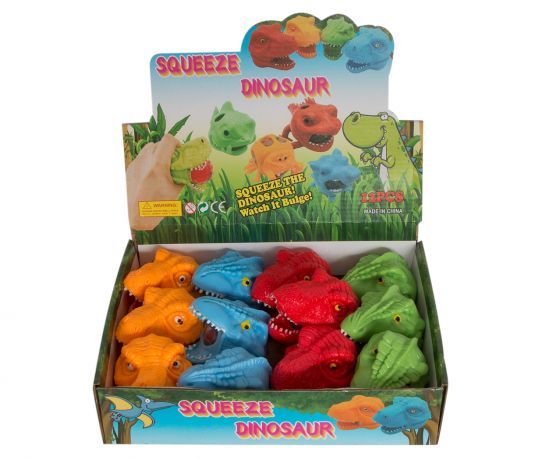We use cookies to make your experience better.
Dino - "blurry" beast (Bestseller)
- Buy 36 for €1.10 each and save 19%
A stress ball in the shape of a globe A stress ball or hand exercise ball is a malleable toy, usually not more than 7 cm in diameter, which is squeezed in the hand and manipulated by the fingers, ostensibly to relieve stress and muscle tension or to exercise the muscles of the hand. Despite the name, many stress balls are not spherical. Some are molded in amusing shapes, and pad- or transfer-printed with corporate logos. They are presented to employees and clients of companies as promotional gifts. Stress balls are the third most popular promotional gift in the United Kingdom. Because of the many non-spherical shapes now available, stress balls are generically known as stress relievers. There are several different types of stress balls that originate from many different countries. The most common type of stress ball in America is the “bean bag” type, commonly known as a “Hacky Sack”. The stress ball that is most common in Australia is the foam type, this type prevents stress through resistance from squeezing the ball. The third type of stress ball is the Chinese form known as the Baoding ball. These are not like the others as these are not squeezable, they are solid, they usually come in pairs so you can roll them together to make a soothing sound and a smooth sensation feeling in your hands.
The dinosaurs and dinosaurs (the first name is the correct translation of Dinosauria, the scientific name of the group) are a group of animals belonging to the Archosauria, which dates back to the Mesozoic. The Dinosauria originated about 230 million years ago in the Triassic, where the division within the wider group of dinosauriformes. The first dinosaur was a small bipedal carnivore. That was the direct ancestor of the two main groups in which all other dinosaurs can be divided: the Saurischia and Ornithischia. In these two groups quickly developed also herbivorous species. The dinosaurs were dominant at the end of the Triassic, when the country became extinct most other large animals. During the subsequent Jurassic and Cretaceous dinosaurs were 140 million years, the dominant land animals, probably the greatest that ever lived. Thousands of species, carnivores and herbivores, developed in various forms, including by moving apart the continents. The marine reptiles of that time and the pterosaurs, flying reptiles, however, were not dinosaurs. At the end of the Cretaceous, 66 million years ago, most dinosaurs became extinct, possibly as a result of a meteorite impact. Living dinosaurs are the birds. Since 1808, in 1842 the extinct dinosaurs are scientifically described and the group got its name, meaning "fierce dinosaurs" means. Between 1870 and 1925 many dinosaur fossils were discovered, particularly in North America. Then the interest declined sharply since 1968 but there is just a substantial revival of the investigation, called "Dinosaur Renaissance". Especially in China and Argentina are hundreds of new species found. There are much improved insights gained about their relationships, structure and habits. Former popular science books on the subject will become totally obsolete. Because of the shape wealth of dinosaurs is to identify the typical characteristics of the group difficult. Not a particular characteristic makes an animal a dinosaur but the fact that he is a descendant of the first dinosaur. Apart from big dinosaurs were, and there are also quite small. Dinosaurs are reptiles and are at least partly scaly skin and reproduce by means of eggs. Unlike other reptiles present, the existing dinosaurs, birds, warm-blooded. Unknown and debatable to what extent the extinct dinosaurs were warm-blooded and possessed a plumage or coat. Small species of dinosaurs had, even if it were no birds, presumably a high metabolism and several of their fossils show the remains of feathers or hair. Most scientists now believe that all dinosaurs, even the largest, were fairly active animals instead of slow or cumbersome, which explains their evolutionary success.












